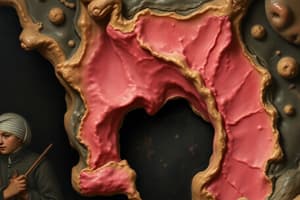Podcast
Questions and Answers
What is necessary for regeneration to occur in healing?
What is necessary for regeneration to occur in healing?
- An absence of inflammation
- The ability of remaining cells to divide and an intact collagen framework (correct)
- The complete destruction of all cells
- The formation of scar tissue
Which factor is crucial for determining the healing process?
Which factor is crucial for determining the healing process?
- The location of the injury
- The presence of bacterial infection
- The nature and type of cells involved (correct)
- The age of the patient
What type of healing involves the formation of immature granulation tissue?
What type of healing involves the formation of immature granulation tissue?
- Primary intention healing
- Regeneration healing
- Secondary intention healing (correct)
- Tertiary intention healing
How many types of cell types are mentioned in the healing process?
How many types of cell types are mentioned in the healing process?
Which statement about regeneration healing is true?
Which statement about regeneration healing is true?
What role do remaining cells play in regeneration during the healing process?
What role do remaining cells play in regeneration during the healing process?
Why is the collagen framework tissue important for healing?
Why is the collagen framework tissue important for healing?
Name one characteristic that distinguishes the three types of cell types involved in healing.
Name one characteristic that distinguishes the three types of cell types involved in healing.
What is immature granulation tissue and when does it occur?
What is immature granulation tissue and when does it occur?
Discuss the significance of cell nature in the healing process.
Discuss the significance of cell nature in the healing process.
Flashcards are hidden until you start studying
Study Notes
Types of Healing
- There are two types of healing: regeneration and repair.
- Regeneration requires remaining cells to be capable of dividing and the collagen framework tissue to be intact.
- Cell nature and type are important for healing
Cell Types
- There are three types of cell types:
- Labile cells
- Stable cells
- Permanent cells
Regeneration
- Regeneration is the process of replacing damaged tissue with the same type of tissue
- It's possible in tissues with labile cells, like the skin and bone marrow.
Immature Granulation Tissue
- Immature granulation tissue is a type of connective tissue that forms during the healing process
- It is characterized by a high number of fibroblasts, collagen, and blood vessels.
- Immature granulation tissue is essential for wound healing as it provides a scaffold for new tissue formation and helps to fill the wound space.
- Over time, immature granulation tissue matures into scar tissue.
Healing
- There are two types of healing: regeneration and repair
- For regeneration to occur:
- Remaining cells must be capable of division
- The collagen framework tissue must be intact
- Cell nature and type are important for healing.
Cell Types
- There are three main cell types involved in healing:
- Labile cells - continuously dividing and regenerating
- Stable cells - normally in a quiescent state (not dividing) but can re-enter the cell cycle when needed
- Permanent cells - do not divide after birth
Regeneration
- Requires the remaining cells to be capable of dividing
- It requires that the framework of the tissue be intact
- Regeneration is ideal for healing
Immature Granulation Tissue
- Characterized by newly formed capillaries, fibroblasts, and inflammatory cells
- Plays a significant role in tissue repair, forming a foundation for new tissue development
- Eventually develops into scar tissue, which is less functional than the original tissue.
Studying That Suits You
Use AI to generate personalized quizzes and flashcards to suit your learning preferences.




